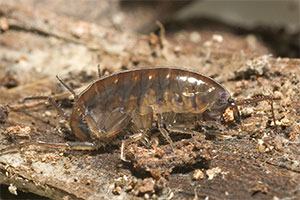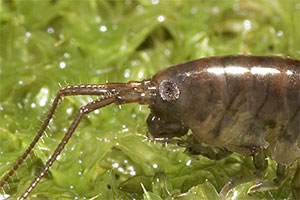|
Amphipoda

Terrestrial Amphipoda, New Zealand.
Common name: landhoppers.
Scientific name: phylum
Arthropoda, class Crustacea, subclass Malacostraca, order
Amphipoda, family Talitridae.
Description
Amphipoda is another group of Crustacea
(see Isopoda) that has adapted to living on land. Most amphipods are aquatic, with the majority being marine. Other amphipods
live in the tidal zone and on beaches, and can be considered
semi-terrestrial. One group – the landhoppers – have become fully terrestrial. All terrestrial amphipod species belong to the family Talitridae. There
are marine and semi-terrestrial Talitridae as well.
Landhoppers are usually 0.5-1.5 cm in length,
and somewhat shrimp-like in appearance. Their bodies are elongated
and compressed laterally, and have a smooth and shiny appearance.
The males can be smaller than the females. Live land hoppers
range in colour from pale ochre or grey to olive-
or reddish-brown, often with a pattern of stripes and spots.
In a manner similar to shrimp and lobsters, landhoppers turn
red once they are dead.
Terrestrial amphipods have elongated body with a distinct head, 7 thoracic segments, and 6 smaller
abdominal segments. The head bears two pairs of antennae (one
pair long and conspicuous, and the second pair very small),
two large compound eyes, and chewing mouthparts. On each thoracic
segment there is a pair of appendages. The first two pairs -
gnathopods - are modified for food processing; the appendages
on segments 3-7 are legs. The last two pairs of legs are
particularly long, robust, and used for jumping. The gills,
if present, are located at the bases of the thoracic legs.
The abdominal segments bear leg-like appendages: pleopods on 2nd and 3rd abdominal segments, and long,
backward-facing uropods on segments 4 and 5.

Head of a landhopper.
Notes on biology
Terrestrial amphipods are most active at
night, when they feed on dead vegetation and various plant
debris. Similar to Isopoda, amphipods dehydrate easily through
their cuticle, and are restricted to damp environments. Several New Zealand species are adapted to
living in coastal soils with high salinity.
Landhoppers breed several times during
the warm seasons of the year. After mating, the female deposits
the eggs into her fluid-filled brood pouch on the underside
of the thorax. The eggs hatch within the brood pouch, and
the young landhoppers are released shortly afterwards. Development
is direct; the young amphipods resemble adults and grow through
a series of moults. After reaching sexual maturity landhoppers
continue to moult and grow throughout their life, which is
quite short - about a year.
Very abundant in many soil habitats of
New Zealand, particularly in the litter of native forests,
landhoppers are an important part of the decomposer community,
as they shred leaf litter and aid in the recycling of soil
nutrients. Landhoppers can be preyed upon by soil predators.
They have been found to be the preferred prey of the carnivorous
native New Zealand land snail Wainuia urnula (Rhytididae)
(Efford, 2000).
Where to find them?
Terrestrial amphipods are restricted to
sheltered, damp environments. They inhabit the leaf litter
and soil of native forests, tall grasslands, scrublands, parks
and gardens. In Fiordland, landhoppers were found living in
the moss of tree canopies. Several native species dig burrows
in the soil, or use burrows made by other soil invertebrates.
Often landhoppers can be found around human houses in garden
mulch, compost, under dense ground cover plantings, or under
any damp pile of plant debris. Many related semi-terrestrial
species (sandhoppers) can be found on the beach, where they
live under driftwood, stones, and piles of decaying algae.
When uncovered in their shelters, landhoppers
rush to escape the light, and will disappear within seconds.
They are quite difficult to capture or to photograph. Unlike
slaters (Isopoda), terrestrial amphipods are difficult to
keep in captivity. They are very sensitive to their environment,
and die quickly if the conditions are too dry or too moist.
Landhoppers can be collected directly, or
in pitfall traps. Berlese funnel extractions often yield amphipods,
although care should be taken that large active specimens
do not escape from the sample during collecting. Landhoppers
can be preserved in 70% alcohol, which needs to be changed
periodically.
Distribution and conservation
Terrestrial amphipods are found on all southern
land masses, which is thought to reflect their origin from the
supercontinent of Gondwana. Landhoppers are common litter
dwellers in New Zealand and Australia, the sub-Antarctic Islands,
the Pacific Islands, Japan and Southeast Asia, Africa, India,
and Central America. Landhoppers did not occur naturally in
the Northern hemisphere, but since the development of man’s
trade routes, the Australasian species have successfully invaded
North America, the British Isles, Ireland, and parts of Europe.
Out of 26 species of terrestrial amphipods
described in New Zealand, 25 are endemic. Native New Zealand
landhoppers inhabit all areas, from coastal zones to inland
forests, and can even be found in alpine habitats. Several
native species are widespread throughout New Zealand, while
most others are restricted to particular habitats and/or locations.
Several species are rare, and one is thought to be extinct.
The endemic terrestrial amphipods of New Zealand are threatened
by habitat destruction due to land conversion, and by the
invasion of introduced species. Only a few native species
have been able to invade modified habitats, such as exotic
pine plantations. There is a danger that some species may
become locally extinct before it is noticed.
The large, very active dark grey landhopper
found in abundance in parks and gardens of human settlements
of the North Island is the introduced species Arcitalitrus
sylvaticus. This ubiquitous species has been introduced
to New Zealand from Australia, and is now the most common
landhopper in modified habitats of the North Island, where
it has displaced native species in many environments, especially
around Auckland and Wellington.
Included images:
- Family Talitridae
- Unidentified species - Ohinetonga Scenic Reserve, TO, North Island (3 images)
- Unidentified species - Sandy Bay, Marahau Road, NN, South Island (2 images)
- Unidentified species - Kaiteriteri Road, NN, South Island (2 images)
- Unidentified species - Hinewai Reserve, Banks Penninsula, MC, South Island (2 images)
- Unidentified species - Tautuku Beach, Caitlins, Southland, SL, South Island (2 images)
- Unidentified species - Okarito Beach, WD, South Island (3 images)
Further information on New Zealand
landhoppers:
Duncan, K.W. 1994. Terrestrial Talitridae
(Crustacea: Amphipoda). Fauna of New Zealand 31, 128 p.
Efford, M. 2000. Consumption of amphipods
by the New Zealand land snail Wainuia urnula (Pulmonata
: Rhytididae). Journal of Molluscan Studies 66, p. 45-52.
Friend, J.A. 1993. The biology of the New
Zealand terrestrial Talitridae. Proceedings of the Entomological
Society of NZ, 1993, p. 40-43.
Friend, J.A., Richardson, A.M.M. 1986.
Biology of Terrestrial Amphipods. Annual Review of Entomology
31, p. 25-48.
Hurley, D.E. 1959. Notes on the ecology
and environmental adaptations of the terrestrial Amphipoda.
Pacific Science 13, p. 107-129.
Pugh, P.J.A., Dartnall, H.J.G, Mcinnes,
S.J. 2002. The non-marine Crustacea of Antarctica and the
Islands of the Southern Ocean: biodiversity and biogeography.
Journal of Natural History 36(9), p. 1047-1103.
Richardson, A.M.M., Jackson, J.E. 1995.
The first record of a terrestrial landhopper (Crustacea, Amphipoda,
Talitridae) from Macquarie Island. Polar Biology 15(6), p. 419-422.
Amphipoda Resources on the Web (terrestrial
only):
Talitridae
(Crustacea: Amphipoda) - by K. Duncan, NZ Landcare Research,
the summary of the Fauna of New Zealand on Amphipoda, .
Terrestrial
Amphipods or "Lawn Shrimp" (Crustacea: Amphipoda),
by Thomas R. Fasulo, University of Florida, includes description
of morphology, life cycle, habitat and control of terrestrial
amphipods in Florida.
Australian
Amphipoda: Essential Literature, by J.K. Lowry, P.B Berents
& R.T. Springthorpe, from Crustacea.net - a comprehensive
list of literature on Australian Amphipoda - includes marine,
freshwater, and terrestrial species.
|